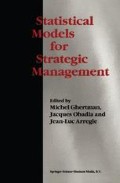Abstract
Four studies are described to illustrate the usage of latent variable structural equations modeling in research on internationalization strategies. The first two studies address the relationship between globalization strategies and structure, and the role of national differences. The third and fourth studies describe factors affecting the performance of international strategic alliances. The literature and theoretical reviews are purposely kept brief, as the paper focuses on methodological issues, with the emphasis on how to apply structural equations modeling techniques. The paper specifically compares PLS and LISREL, the two most common structural equations modeling techniques used in empirical testing.
The authors thank Aya Chacar, Ph.D candidate, UCLA, for her help with this paper; and the Marketing Science Institute, the Center for International Business Education and Research at UCLA, and NFR/NORAS, Norway (grant No. 2151309) for their support of the earlier studies on which this paper is based.
Access this chapter
Tax calculation will be finalised at checkout
Purchases are for personal use only
Preview
Unable to display preview. Download preview PDF.
References
Anderson, J.C., and D.W. Gerbing (1988), “Structural Equation Modeling in Practice: A Review and Recommended Two-Step Approach,” Psychological Bulletin, 103 (3), pp. 411–423.
Badaracco, Joseph L. (1991), The Knowledge Link: How Firms Compete Through Strategic Alliances, Harvard Business School Press, Boston, MA.
Bagozzi, R.P., and C. Fomell (1982), “Theoretical Concepts, Measurement, and Meaning”, in Fomell, C., (ed.), A Second Generation of Multivariate Analysis, Vol. II, Praeger, New York, NY, pp. 24–38.
Bagozzi, R.P., and L.W. Phillips (1982), “Representing and Testing Organizational Theories: A Holistic Construct”, Administrative Science Quarterly, 27, pp. 459–489.
Bentler, Peter M., and D. G. Bonett (1980), “Significance Tests and Goodness of Fit in the Analysis of Covariance Structures,” Psychological Bulletin, 88, pp 586–606.
Boomsma, A (1983), On the Robustness of LISREL (Maximum Likelihood Estimation) Against Small Sample Size and Non-Normality, doctoral dissertation, University of Groningen, Holland.
Chakravarthy, B., and Y. Doz (1992), “Strategy process research: focusing on corporate self-renewal,” Strategic Management Journal, Summer Special Issue, Vol. 13, pp. 5–14.
Dijkstra, T (1983), “Some Comments on Maximum Likelihood and Partial Least Squares Methods”, Journal of Economics, Vol. 22, pp. 67–90.
Fomell, C (1982), “A Second Generation of Multivariate Analysis: An Overview”, in Fomell, C., (ed.), A Second Generation of Multivariate Analysis, Vol. I, Praeger, New York, NY, pp. 1–21.
Fomell, C (1987), “A Second Generation of Multivariate Analysis: Classifications of Methods and Implications for Marketing Research”, in Houston, M., (ed.), Review of Marketing 1987, American Marketing Association, University of Minnesota, pp. 407–450.
Fomell, C., and F.L. Bookstein (1987), “Two Structural Equation Models: LISREL and PLS Applied to Consumer Exit-Voice Theory”, Journal of Marketing Research, Vol. XIX, pp. 440–452.
Fomell, C., Lorange, P. and J. Roos (1990), “The Cooperative Venture Formation Process: A Latent Variable Structural Modeling Approach,” Management Science, Special Issue on State of the Art in Theory and Methodology in Strategy Research, Vol. 36, No. 10, pp. 1246–1255.
Geisser, S (1974) “A Predictive Approach to the Random Effect Model”, Biometrica, Vol. 61, pp. 101–107.
Hamel, G (1991), Competition for competence and inter-partner learning within international strategic alliances, SMJ, Vol. 12, pp. 83–103.
Inkpen, A., and M. Crossan (1995), Believing is seeing: joint ventures and organizational learning, Journal of Management Studies, Vol. 32, pp. 595–618.
Johansson, Johny K., and George S. Yip (1994) “Exploiting Globalization Potential: U.S. and Japanese Strategies,” Strategic Management Journal, October, pp. 579–601.
Jöreskog, K.G., and H. Wold, (eds.), (1982), Systems under Indirect Observations, Part I and II, North-Holland, Amsterdam.
Jöreskog, K.G., and H. Wold (1982), “The ML and PLS Techniques for Modeling with Latent Variables: Historical and Comparative Aspects”, in Jöreskog, K.G., and H. Wold, (eds.), Systems under Indirect Observations, Part I, North-Holland, Amsterdam, pp. 263–270.
Jöreskog, K.G., and D. Sörbom (1979), Advances in Factor Analysis and Structural Equation Models, Abt Ass., Cambridge, MA.
Luijben, T (1989), Statistical Guidance for Model Modification in Covariance Structure Analysis, Sociometric Research Foundation, Amsterdam, Holland.
Lohmöller, J (1982), “An Overview of Latent Variables Path Analysis.” Paper presented at the Annual Meeting of the American Educational Research Association, New York.
Lohmöller, J-B (1984), LVPLS: Program Manual, Version 1. 6, Zentralarchiv flir Empirische Sozialforschung, University of Köln.
Lyles, M (1994), The impact of organizational learning on joint venture formation, International Business Review, Special Issue, Vol. 3., No. 4, pp. 459–468.
Saris, W., and H. Stronkhorst (1984), Causal Modeling in Non-experimental Research, Sociometric Research Foundation, Amsterdam.
Stone, M (1974), “Cross-validatory choice and assessment of statistical predictions”, Journal of the Royal Statistical Society, B 36, pp. 111–147.
Tukey, J.W (1958), “Bias and Confidence in Not-Quite Large Samples”, Annals of Mathematical Statistics, 29: 614.
Wathne, K., Roos, J., and G. von Krogh (1996), “Towards a theory of knowledge transfer in cooperative strategies,” in von Krogh, G., and J. Roos (Eds.), Managing Knowledge: Perspectives on Cooperation and Competition, SAGE Publications, London.
Wold, H., “Introduction”, in Wold, H (1990), (ed.), Theoretical Empiricism,Paragon House, New York, NY, pp. vii-XL.
Wold, H (1982), “Soft Modeling: The Basic Design and Some Extensions”, in Jöreskog, K.G., and H. Wold, (eds.), Systems under Indirect Observations, Part II, North-Holland, Amsterdam, pp. 1–54.
Yip, George S., Johny K. Johansson, and Johan Roos (1996), “Effects of Nationality on Global Strategy,” Marketing Science Institute report.
Yip, George S (1996), “A ‘Borderless’ World - Issues and Evidence,” in W. F. Shepherd and Yan Islam, eds., Current Issues in International Business, Edward Elgar Publishing Ltd., Cheltenham, United Kingdom.
Author information
Authors and Affiliations
Editor information
Editors and Affiliations
Rights and permissions
Copyright information
© 1997 Springer Science+Business Media Dordrecht
About this chapter
Cite this chapter
Roos, J., Yip, G.S., Johansson, J.K. (1997). Using Partial Least Squares and LISREL to Research International Strategies. In: Ghertman, M., Obadia, J., Arregle, JL. (eds) Statistical Models for Strategic Management. Springer, Boston, MA. https://doi.org/10.1007/978-1-4757-2614-5_5
Download citation
DOI: https://doi.org/10.1007/978-1-4757-2614-5_5
Publisher Name: Springer, Boston, MA
Print ISBN: 978-1-4419-5186-1
Online ISBN: 978-1-4757-2614-5
eBook Packages: Springer Book Archive

